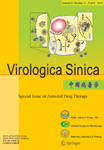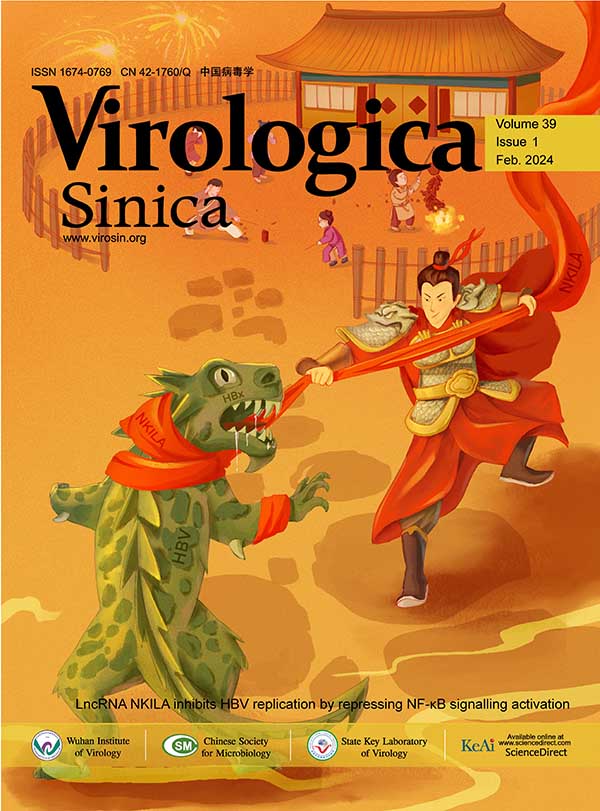Viral diseases were largely untreatable 40 years ago. The first antivirals were developed in the 1960s, mostly to deal with herpes viruses, and were found using traditional trial-and-error drug discovery methods. This was a time-consuming, hit-or-miss procedure, performed in the absence of a good knowledge of how the virus propagated. It was not until the 1980s, when the full genetic sequences of viruses began to be unraveled, that researchers began to understand the virus life cycle in detail, and exactly what chemicals were needed to inhibit the specific reproductive steps. Now dozens of antiviral treatments are available, and medical research is rapidly exploiting new knowledge and technology to develop additional therapies. However there is still no or limited treatment available for many viral infections. Viral diseases such as human immunodeficiency virus (HIV), hepatitis B virus (HBV) and hepatitis C virus (HCV) have a major threat on human health in China and throughout the world. Furthermore, established viruses are now developing resistance to available therapies making this another important area for continued drug discovery.
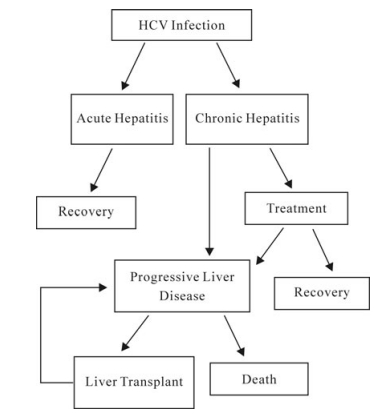
Hepatitis C Virus Experimental Model Systems and Antiviral drug Research
2010, 25(4): 227 doi: 10.1007/s12250-010-3134-0
An estimated 130 million people worldwide are chronically infected with hepatitis C virus (HCV) making it a leading cause of liver disease worldwide. Because the currently available therapy of pegylated interferon-alpha and ribavirin is only effective in a subset of patients, the development of new HCV antivirals is a healthcare imperative. This review discusses the experimental models available for HCV antiviral drug research, recent advances in HCV antiviral drug development, as well as active research being pursued to facilitate development of new HCV-specific therapeutics.

Development of Novel Antiviral Therapies for Hepatitis C Virus
2010, 25(4): 246 doi: 10.1007/s12250-010-3140-2
Over 170 million people worldwide are infected with hepatitis C virus (HCV), a major cause of liver diseases. Current interferon-based therapy is of limited efficacy and has significant side effects and more effective and better tolerated therapies are urgently needed. HCV is a positive, single-stranded RNA virus with a 9.6 kb genome that encodes ten viral proteins. Among them, the NS3 protease and the NS5B polymerase are essential for viral replication and have been the main focus of drug discovery efforts. Aided by structure-based drug design, potent and specific inhibitors of NS3 and NS5B have been identified, some of which are in late stage clinical trials and may significantly improve current HCV treatment. Inhibitors of other viral targets such as NS5A are also being pursued. However, HCV is an RNA virus characterized by high replication and mutation rates and consequently, resistance emerges quickly in patients treated with specific antivirals as monotherapy. A complementary approach is to target host factors such as cyclophilins that are also essential for viral replication and may present a higher genetic barrier to resistance. Combinations of these inhibitors of different mechanism are likely to become the essential components of future HCV therapies in order to maximize antiviral efficacy and prevent the emergence of resistance.
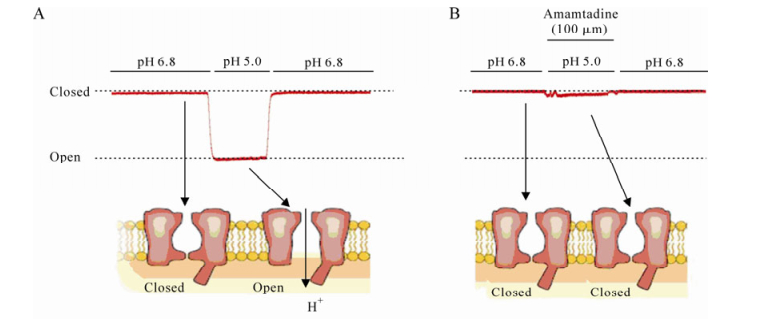
Ion Channels as Antivirus Targets
2010, 25(4): 267 doi: 10.1007/s12250-010-3136-y
Ion channels are membrane proteins that are found in a number of viruses and which are of crucial physiological importance in the viral life cycle. They have one common feature in that their action mode involves a change of electrochemical or proton gradient across the bilayer lipid membrane which modulates viral or cellular activity. We will discuss a group of viral channel proteins that belong to the viroproin family, and which participate in a number of viral functions including promoting the release of viral particles from cells. Blocking these channel-forming proteins may be “lethal”, which can be a suitable and potential therapeutic strategy. In this review we discuss seven ion channels of viruses which can lead serious infections in human beings: M2 of influenza A, NB and BM2 of influenza B, CM2 of influenza C, Vpu of HIV-1, p7 of HCV and 2B of picornaviruses.
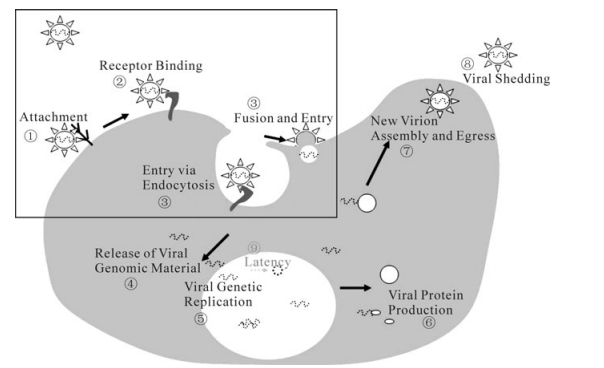
针对病毒感染早期阶段的抗病毒药物筛选
2010, 25(4): 281 doi: 10.1007/s12250-010-3135-z
病毒的感染首要是进入宿主细胞。如果病毒无法侵入,必然也无法实现其感染和复制。因此,病毒侵入这一步骤是抗病毒药物的重要靶标。病毒的感染复制周期通常包括以下几个重要步骤:细胞表面的吸附、侵入、复制、组装以及释放。对于一些病毒还包括潜伏感染这一阶段。病毒感染早期指的是病毒的吸附、受体的结合以及侵入。这些步骤涵盖了病毒与宿主细胞的早期相互作用,因而在很大程度上决定了病毒感染的趋性、病毒复制的特点及其与病毒感染相关疾病的特性。正因为病毒感染早期的重要性,这一阶段是许多跨国药厂抗病毒药物研发的重点目标。本文分别以单纯疱疹病毒(HSV)、丙型肝炎病毒(HCV)、肠道病毒71(EV71)作为有囊膜的DNA病毒、有囊膜的RNA病毒以及无囊膜病毒的代表,总结了当前病毒入侵机制的研究结果,列举了入侵抑制物的各类筛选策略。
Development of Novel Therapeutics for Chronic Hepatitis B
2010, 25(4): 294 doi: 10.1007/s12250-010-3138-9
Chronic infection of hepatitis B virus (HBV) presents one of the serious public health challenges worldwide. Current treatment of chronic hepatitis B (CHB) is limited, and is composed of interferon and nucleoside/nucleotide reverse transcriptase inhibitors (NRTI). Interferon is poorly tolerated and is only responsive in a small fraction of CHB patients and NRTIs often face the problem of emergence of drug resistance during long-term treatment. The current treatment of CHB can be improved in several ways including genotyping mutations associated with drug resistance before treatment to guide the choice of NRTIs and suitable combinations among NRTIs and interferon. It is important to continue research in the identification of novel therapeutic targets in the life cycle of HBV or in the host immune system to stimulate the development of new antiviral agents and immunotherapies. Several antiviral agents targeting HBV entry, cccDNA, capsid formation, viral morphogenesis and virion secretion, as well as two therapeutic vaccines are currently being evaluated in preclinical studies or in clinical trials to assess their anti-HBV efficacy.
抗HIV药物体外药效学研究的几个特殊问题
2010, 25(4): 301 doi: 10.1007/s12250-010-3139-8
随着抗逆转录病毒治疗的广泛开展,HIV的耐药性越来越突出,已经严重影响了抗病毒治疗的效果。这要求我们开发更多新的毒性更小、更有效的抗HIV药物。为了提高提高药物研发的效率,除了常规的抗病毒活性评价,我们在临床前药效学研究中就要关注以下问题:药物的作用机制、药物对耐药病毒株的抑制活性、血浆蛋白结合对药物活性的影响及其与现有药物的联合应用。
- [01/11]《中国病毒学(英文)》期刊编辑部招聘启事
- [05/07]Q1区!VS最新影响因子5.5!
- [22/02]2022年VS高被引论文奖发布
- [21/10]第十届新生病毒性疾病控制学术研讨会 | 第一轮通知
- [09/09]肝癌细胞中CK1α上调IFNAR1的表达,从而促进I型IFN抑制HBV复制
- [09/09]一种新的干扰素诱导的长非编码RNA ZAP-IT1阻断寨卡病毒在A549细胞中的复制
- [09/09]首发精神分裂症中,驯化的人内源性逆转录病毒W家族包膜蛋白通过降低5-HT4受体的水平激活SK2
- [09/09]发热伴血小板减少综合征病毒L蛋白功能域和保守残基研究为理解病毒RNA转录/复制机制提供新思路
- [09/09]亲环素A结合AKT1并通过介导AKT/mTOR/NF-κB正反馈环路的激活促进EB病毒的致瘤作用 | VS推荐
- [09/09]转录组分析显示克里米亚刚果出血热病毒调控的关键细胞过程及III型干扰素的抗病毒作用 | VS推荐







